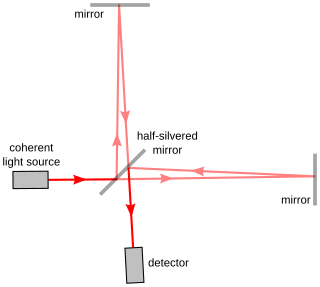 W
WInterferometry is a technique in which waves, usually electromagnetic waves, are superimposed, causing the phenomenon of interference, which is used to extract information. Interferometry is an important investigative technique in the fields of astronomy, fiber optics, engineering metrology, optical metrology, oceanography, seismology, spectroscopy, quantum mechanics, nuclear and particle physics, plasma physics, remote sensing, biomolecular interactions, surface profiling, microfluidics, mechanical stress/strain measurement, velocimetry, optometry, and making holograms.
 W
WCoherence scanning interferometry (CSI) refers to a class of optical surface measurement methods wherein the localization of interference fringes during a scan of optical path length provides a means to determine surface characteristics such as topography, transparent film structure, and optical properties. CSI is currently the most common interference microscopy technique for areal surface topography measurement. The term "CSI" was adopted by the International Organization for Standardization (ISO).
 W
WDifferential interference contrast (DIC) microscopy, also known as Nomarski interference contrast (NIC) or Nomarski microscopy, is an optical microscopy technique used to enhance the contrast in unstained, transparent samples. DIC works on the principle of interferometry to gain information about the optical path length of the sample, to see otherwise invisible features. A relatively complex optical system produces an image with the object appearing black to white on a grey background. This image is similar to that obtained by phase contrast microscopy but without the bright diffraction halo. The technique was developed by Polish physicist Georges Nomarski in 1952.
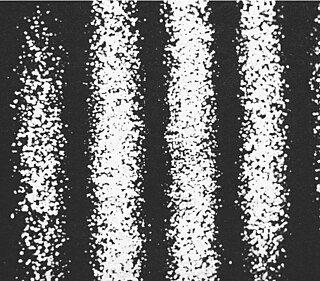 W
WElectronic speckle pattern interferometry (ESPI), also known as TV Holography, is a technique which uses laser light, together with video detection, recording and processing to visualise static and dynamic displacements of components with optically rough surfaces. The visualisation is in the form of fringes on the image where each fringe normally represents a displacement of half a wavelength of the light used.
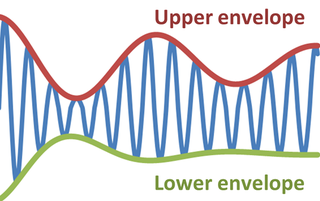 W
WIn physics and engineering, the envelope of an oscillating signal is a smooth curve outlining its extremes. The envelope thus generalizes the concept of a constant amplitude into an instantaneous amplitude. The figure illustrates a modulated sine wave varying between an upper and a lower envelope. The envelope function may be a function of time, space, angle, or indeed of any variable.
 W
WIn quantum mechanics, the uncertainty principle is any of a variety of mathematical inequalities asserting a fundamental limit to the accuracy with which the values for certain pairs of physical quantities of a particle, such as position, x, and momentum, p, can be predicted from initial conditions.
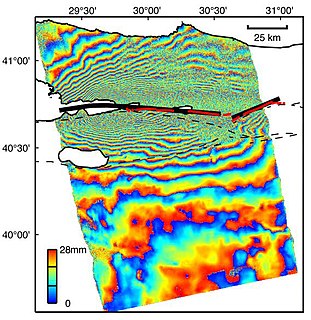 W
WInterferometric synthetic aperture radar, abbreviated InSAR, is a radar technique used in geodesy and remote sensing. This geodetic method uses two or more synthetic aperture radar (SAR) images to generate maps of surface deformation or digital elevation, using differences in the phase of the waves returning to the satellite or aircraft. The technique can potentially measure millimetre-scale changes in deformation over spans of days to years. It has applications for geophysical monitoring of natural hazards, for example earthquakes, volcanoes and landslides, and in structural engineering, in particular monitoring of subsidence and structural stability.
 W
WMultiple satellite imaging is the process of using multiple satellites to gather more information than a single satellite so that a better estimate of the desired source is possible. So something that cannot be seen with one telescope might be visible with two or more telescopes.
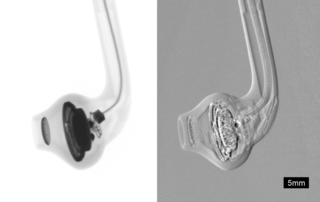 W
WPhase-contrast X-ray imaging (PCI) or phase-sensitive X-ray imaging is a general term for different technical methods that use information concerning changes in the phase of an X-ray beam that passes through an object in order to create its images. Standard X-ray imaging techniques like radiography or computed tomography (CT) rely on a decrease of the X-ray beam's intensity (attenuation) when traversing the sample, which can be measured directly with the assistance of an X-ray detector. In PCI however, the beam's phase shift caused by the sample is not measured directly, but is transformed into variations in intensity, which then can be recorded by the detector.
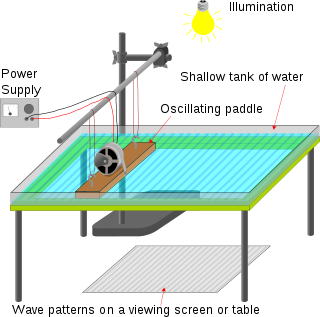 W
WIn physics, a ripple tank is a shallow glass tank of water used to demonstrate the basic properties of waves. It is a specialized form of a wave tank. The ripple tank is usually illuminated from above, so that the light shines through the water. Some small ripple tanks fit onto the top of an overhead projector, i.e. they are illuminated from below. The ripples on the water show up as shadows on the screen underneath the tank. All the basic properties of waves, including reflection, refraction, interference and diffraction, can be demonstrated.
 W
WThe Sagnac effect, also called Sagnac interference, named after French physicist Georges Sagnac, is a phenomenon encountered in interferometry that is elicited by rotation. The Sagnac effect manifests itself in a setup called a ring interferometer. A beam of light is split and the two beams are made to follow the same path but in opposite directions. On return to the point of entry the two light beams are allowed to exit the ring and undergo interference. The relative phases of the two exiting beams, and thus the position of the interference fringes, are shifted according to the angular velocity of the apparatus. In other words, when the interferometer is at rest with respect to a nonrotating frame, the light takes the same amount of time to traverse the ring in either direction. However, when the interferometer system is spun, one beam of light has a longer path to travel than the other in order to complete one circuit of the mechanical frame, and so takes longer, resulting in a phase difference between the two beams. This arrangement is also called a Sagnac interferometer. Georges Sagnac set up this experiment to prove the existence of the aether that Einstein's theory of special relativity had discarded.
 W
WA scintillometer is a scientific device used to measure turbulent fluctuations of the refractive index of air caused by variations in temperature, humidity, and pressure. It consists of an optical or radio wave transmitter and a receiver at opposite ends of an atmospheric propagation path. The receiver detects and evaluates the intensity fluctuations of the transmitted signal, called scintillation.
 W
WInterferometry examines the general interference phenomena between pairs of signals in order to gain useful information about the subsurface. Seismic interferometry (SI) utilizes the crosscorrelation of signal pairs to reconstruct the impulse response of a given media. Papers by Keiiti Aki (1957), Géza Kunetz, and Jon Claerbout (1968) helped develop the technique for seismic applications and provided the framework upon which modern theory is based.
 W
WSpeckle imaging describes a range of high-resolution astronomical imaging techniques based on the analysis of large numbers of short exposures that freeze the variation of atmospheric turbulence. They can be divided into the shift-and-add method and the speckle interferometry methods. These techniques can dramatically increase the resolution of ground-based telescopes, but are limited to bright targets.
 W
WIn ultrafast optics, spectral phase interferometry for direct electric-field reconstruction (SPIDER) is an ultrashort pulse measurement technique originally developed by Chris Iaconis and Ian Walmsley.
 W
WVelocity interferometer system for any reflector (VISAR) is a time-resolved velocity measurement system that uses laser interferometry to measure the surface velocity of solids moving at high speeds. For solids experiencing high velocity impact or explosive conditions, VISAR plots the free-surface velocity against time to show the shock wave profile of a material. VISAR is a useful tool in determining the pressure-density relationship of a material known as the Rankine-Hugoniot conditions or simply the "Hugoniot".
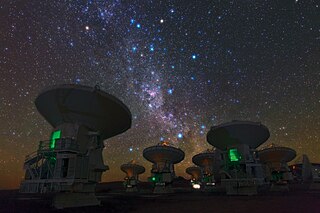 W
WVery-long-baseline interferometry (VLBI) is a type of astronomical interferometry used in radio astronomy. In VLBI a signal from an astronomical radio source, such as a quasar, is collected at multiple radio telescopes on Earth or in space. The distance between the radio telescopes is then calculated using the time difference between the arrivals of the radio signal at different telescopes. This allows observations of an object that are made simultaneously by many radio telescopes to be combined, emulating a telescope with a size equal to the maximum separation between the telescopes.
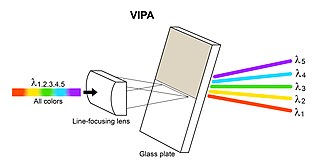 W
WA virtually imaged phased array (VIPA) is an angular dispersive device that, like a prism or a diffraction grating, splits light into its spectral components. It works almost independently of polarization. In contrast to prisms or regular diffraction gratings, it has a much higher angular dispersion but has a smaller free spectral range. This aspect is similar to that of an Echelle grating which is usually used in reflection, since high diffraction orders are also used there. The VIPA can be a compact optical component with high wavelength resolving power.
 W
WAs described here, white light interferometry is a non-contact optical method for surface height measurement on 3-D structures with surface profiles varying between tens of nanometers and a few centimeters. It is often used as an alternative name for coherence scanning interferometry in the context of areal surface topography instrumentation that relies on spectrally-broadband, visible-wavelength light.